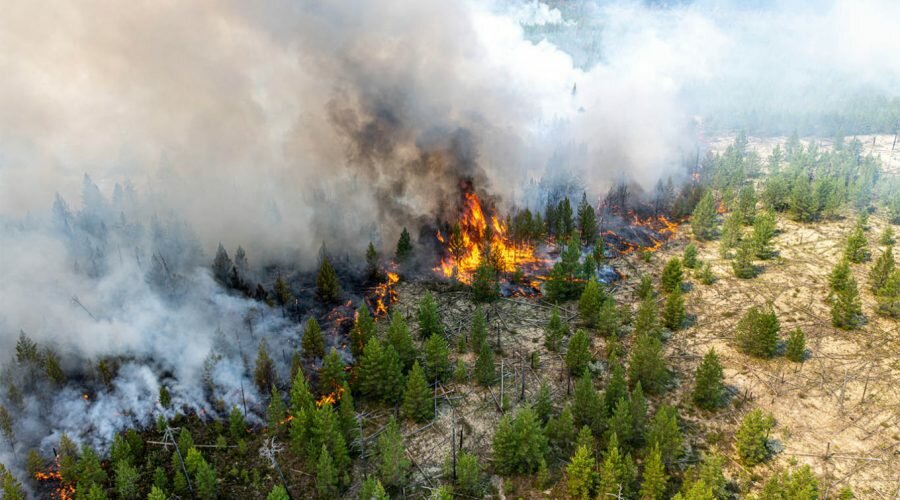The Biden administration has announced a new phase in the war against devastating wildfires. Unlike the firefighting strategies of decades past, which focused on putting out fires as quickly as possible, the president’s new plan is all about minimizing risks.
As climate change heats up and dries out the West, administration officials said they have crafted a $50 billion plan to more than double the use of controlled fires and logging to reduce trees and other vegetation that serves as tinder in the most at-risk areas.
Beginning this year, the US Forest Service will focus on regions where devastating blazes have wiped out houses and sometimes entire communities – including California’s Sierra Nevada mountains, the east side of the Rocky Mountains in Colorado, and portions of Arizona, Oregon and Washington state.
“You’re going to have forest fires,” Agriculture Secretary Tom Vilsack, whose department oversees the Forest Service, told the Associated Press. “The question is how catastrophic do those first have to be.”
The time to act is now if we want to ultimately over time change the trajectory of these fires, Vilsack said.
Specific projects weren’t immediately released, and it’s not clear who would pay for the full scope of work envisioned across almost 80,000 square miles (200,000 square kilometers) an area almost as large as Idaho. Much of that area is controlled by states, tribes or is privately owned.
A 10 year plan to tackle wildfires – and save lives over acres
Reaching that goal would require an estimated $20 billion over 10 years for work on national forests and $30 billion for work on other federal, state, tribal and private lands, said Vilsack spokesperson Kate Waters.
Vilsack acknowledged that the new effort will also require a paradigm shift within the U.S. Forest Service, from an agency devoted to stamping out fires, into one that uses what some Native Americans call good fire on forests and rangeland to prevent even larger blazes.
Forest Service planning documents indicate the work will focus on hotspots that make up only 10% of the fire-prone areas across the U.S. but account for 80% of risk to communities because of their population densities and locations.
The recently-passed federal infrastructure bill put a down payment on the initiative $3.2 billion over five years that Vilsack said will get work going quickly.
Wildfire expert John Abatzoglou said lessening fire dangers on the amount of land envisioned under the administration’s plan is a lofty goal” that represents even more acreage than burned over the past 10 years across the West. But Abatzoglou, a University of California Merced engineering professor, said the focus on wildfire hazards closest to communities makes sense.
Our scorecard for fire should be about lives saved rather than acres that didn’t burn, he said.
Rare winter blazes signal that action is needed now
Dealing with western wildfires is becoming increasingly urgent as they get more destructive and intense. There have been rare winter blazes in recent weeks, including infernos in Montana and Colorado, where a wildfire on Dec. 30 tore through a suburban area and destroyed more than 1,000 buildings, leaving one person dead and a second still missing.
And there’s no signs of a let-up in conditions that keep the risk of wildfires extremely high. A long-term megadrought is gripping the region and scientists forecast temperatures will keep rising as more climate-changing carbon emissions are pumped into the atmosphere.
The impact stretches far beyond the western U.S. because massive smoke plumes at the height of wildfire season in the U.S. and Canada spread the health effects across North America sending unhealthy pollution last summer to major cities from San Francisco to Philadelphia and Toronto.
For decades the primary approach to containing and extinguishing forest fires was to try to stamp them out. The efforts have been similar to massive, military-like campaigns, including planes, fleets of heavy equipment and thousands of firefighting personnel and support workers dispatched to the fire zones.
However, fires are a part of the natural cycle for most forests, so putting them out leaves stands of trees that don’t burn surrounded by dead wood, underbrush and other highly flammable fuels a worst-case scenario when blazes ignite.
Critics say the plan will ‘hurt forests and wildlife’
Not everyone has welcomed the new strategy, however. Critics say the government’s plan to use logging to reduce fire damages will hurt both forests and the wildlife and water supplies that depend on them.
In South Dakota’s Black Hills, for example, government biologists have said that too many trees dying from a combination of insects, fire and logging have made current timber harvest levels unsustainable.
“The US Forest Service simply cannot log its way out of the climate crisis,” said Adam Rissien from the environmental group WildEarth Guardians.

